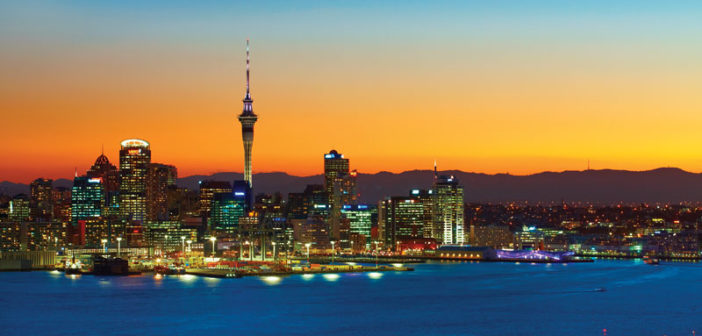INTERNATIONAL REPORT—The performance of New Zealand’s hotel industry improved for the fifth year in a row in 2017, thanks to continuing strong growth in international visitors and almost no growth in room supply.
However, new supply is starting to come online with a strong pipeline, occupancy growth is slowing, and there is competition from Airbnb. But the mood of the industry is buoyant, according to a report by Stephen Hamilton, managing director with Horwath HTL New Zealand.
Tourists are drawn to the country because of its diversity of activities, according to Tourism New Zealand. “New Zealand is jam-packed with things to do—it’s like taking three vacations in one thanks to our diverse landscapes,” said Bjoern Spreitzer, GM for the Americas with Tourism New Zealand. “From hiking, water activities, culture, food and wine, wildlife encounters, adventure sports, golf and cycling, there’s something for everyone… Visitors always say they come for the landscapes but leave impressed by our welcoming and friendly people.”
Another draw for New Zealand is that was also the home for the filming of The Lord of the Rings and The Hobbit. The tourism industry has taken advantage of the film series’ major popularity by creating themed tours of the sets and several hotels inspired by the films.
“The New Zealand hotel industry has been experiencing a period of strong growth in demand, while simultaneously, supply increases have been constrained,” Hamilton said. “As a result, the average occupancy rate (AOR) has risen 10 points in five years. In the major hotels, AOR is now over 80%. Average room rates have also risen strongly—by 40% in the major hotels over the past five years.”
Queenstown is currently the strongest performing hotel market in the country, followed by Auckland. “AOR in Queenstown in 2018 was 83% at an ADR of NZD245 ($163),” he said. “In Auckland, the AOR was 84% at an ADR of NZD207 ($138). Auckland has 30% of the room supply, Queenstown 10%.”
Hotels in some regions, such as Central Park and Wellington, were able to make strong gains in both ADR and occupancy. “Hotels in some other regions incurred modest reductions in occupancy as a result of some dispersal of visitor demand (especially group tour demand) to adjacent regions; some displacement of domestic guests, replaced by international guests paying higher prices; and some loss of market share of guest nights from hotels to other forms of commercial and private accommodation,” said Hamilton.
Tourism is the largest export industry, followed closely by dairy. “The increase in hotel demand has been significantly helped by stronger-than-expected growth in inbound visitors to New Zealand over the past five years (average of 8% per annum), with growth in all main markets,” he said. “The strongest inbound growth over the period (16% per annum) has been from China, which is now the second largest inbound market for New Zealand, after Australia. Total international visitor arrivals have increased from 2.5 million in 2012 to 3.8 million in 2018.”
Hamilton continued, “With $36 billion of combined international and domestic visitor expenditure in the year ended March 2017, New Zealand is more than on track to achieve Tourism Industry Aotearoa’s (TIA’s) aspirational goal of $41 billion of spending by 2025. The Tourism Satellite Account, published by Stats NZ, shows that domestic visitor expenditure increased by 4% in the year ended March 2017. The trend of strong growth in international visitor arrivals continued in 2017 with 6.7% growth to 3.7 million visitors.”
A majority of hotel guests are domestic travelers. “There are more overnight domestic visitors than international visitors, but because the average length of stay of domestic visits is shorter, domestic visitor nights are roughly equivalent to international visitor nights,” said Hamilton. “The ratio is similar in terms of hotel guest demand (i.e., 50% domestic, 50% international).”
The future holds a positive outlook. “By the end of 2018, nine hotels totaling 1,345 rooms opened in New Zealand’s main visitor centers,” said Hamilton. “Nine more, totaling 1,409 rooms, are expected to open this year.”
According to Spreitzer, the country’s hotel market is filled with opportunity. “Thanks to the increase in visitor arrivals, the hotel development scene is also on the rise to meet the demand. There are dozens of developments across the country that we are hopeful will open by 2021. International hotel brands, including Park Hyatt, SO/Sofitel, Cordis, Ritz-Carlton, and InterContinental, have all announced plans or opened new hotels in the past year.”
The latest “New Zealand Tourism Forecasts 2018-2024” issued by the Ministry of Business, Innovation and Employment (MBIE) projects a 4.9% increase in visitor arrivals in 2018 and a 5.4% increase in 2019 to 4.1 million arrivals. “Chinese visitor arrivals projections have been revised downward following lower-than-expected growth (2.3%) in 2017,” said Hamilton. “MBIE is still projecting Chinese arrivals to grow by 10% in 2018 and by 11% in 2019, with a 7% increase in direct air capacity cited as an important driver. Growth in Chinese arrivals in 2019 will benefit from the China-New Zealand Year of Tourism, with both countries promoting and facilitating tourism.”
Arrivals by U.S. visitors are projected to grow by 10% in 2018 and an additional 9.5% in 2019, he said. Favorable economic conditions are expected to offset a 3% reduction in direct flight capacity occurring in 2018.
Hotel room supply will expand over the next five years, especially in Auckland, where at least a 60% increase in room supply is expected. “This is likely to result in annual occupancies falling by approximately eight points by 2022, before recovering as future demand increases again exceed supply increases,” Hamilton said. “Hotel demand in Auckland will be supported by the New Zealand International Convention Centre, opening in 2020, hosting The America’s Cup again in Auckland in 2021, and hosting APEC in the same year.”
He continued, “The outlook is positive for inbound visitors to New Zealand and hotel demand throughout 2018 and 2019. However, we are projecting minor reductions in occupancy in some locations following the introduction of significant new room supply. Despite increased competition and falling occupancies, our room rate projections remain generally positive.”
Hamilton believes sophisticated hotel revenue management systems will enable hoteliers to maintain room rates. “Significant increases in hotel supply are expected in 2020 and ’21, so room rate response to increased competition will be important,” he said. “We hope the hotel industry can avoid the ‘boom and bust’ conditions previously experienced in New Zealand.”
He cautioned hotel investors and developers: “Be aware of the risks of expanding hotel supply too rapidly in what is a series of small markets, where most destinations are affected by seasonality of demand,” he said. “Hotel investment can’t be justified by building new capacity to accommodate only peak-season demand.” HB


